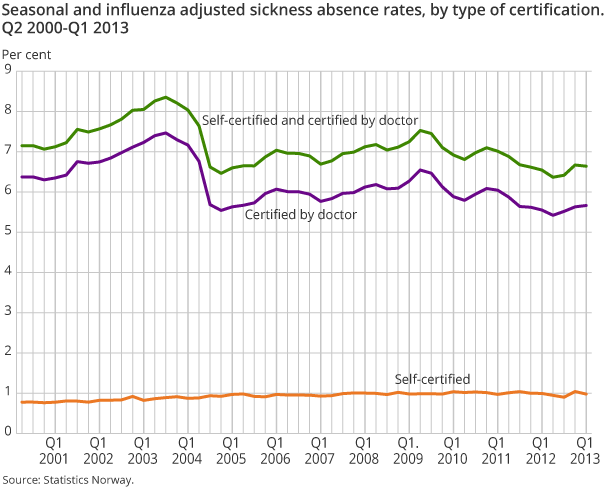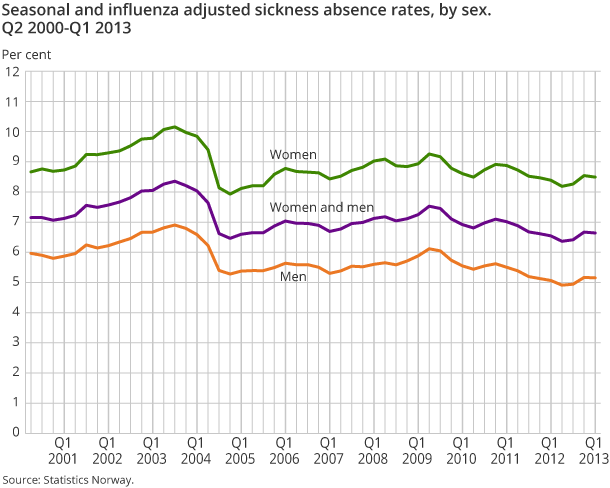Content
Published:
This is an archived release.
Stable seasonally-adjusted sickness absence
Sickness absence adjusted for seasonal and influenza variations was 6.6 per cent in the 1st quarter of 2013 - a marginal decrease of 0.4 per cent from the 4th quarter of 2012.
| 1st quarter 2013 | Per cent from previous quarter | |
|---|---|---|
| 1The sickness absence rates are shown to two decimal points. In other tables the rates are shown with one decimal point. More decimal points are used when calculating the rates of change in order to get more accurate figures. These will therefore differ slightly from the rates of change produced when using the published rounded figures. | ||
| Both sexes | ||
| Self-certified and certified by doctor | 6.64 | -0.4 |
| Self-certified | 0.98 | -6.1 |
| Certified by doctor | 5.66 | 0.6 |
| Males | ||
| Self-certified and certified by doctor | 5.15 | -0.3 |
| Self-certified | 0.86 | -5.0 |
| Certified by doctor | 4.29 | 0.8 |
| Females | ||
| Self-certified and certified by doctor | 8.49 | -0.6 |
| Self-certified | 1.12 | -7.1 |
| Certified by doctor | 7.37 | 0.5 |
The self-certified sickness absence decreased by 6.1 per cent, while the doctor-certified absence rose by 0.6 per cent. Sickness absence decreased for both women and men - by 0.6 and 0.3 per cent respectively.
Since the 2nd quarter of 2001, when the agreement on an inclusive labour market was implemented, the seasonal and influenza-adjusted sickness absence has dropped by 8.1 per cent.
Statistics without seasonal and influenza adjustment
Since the following comments in this article are based on data that is not adjusted for seasonal and influenza variations, we look at changes over the past year, from the 1st quarter of 2012 to the 1st quarter of 2013.
Sickness absence was 7.2 per cent in the 1st quarter of 2013 - an increase of 4.4 per cent last year. The self-certified sickness absence rate increased by 5.4 per cent and the doctor-certified rate increased by 4.1 per cent.
Increase for both men and women
Sickness absence among women increased from 8.9 to 9.2 per cent, while rising from 5.4 to 5.7 per cent for men; an increase of 3.5 and 5.3 per cent respectively.
Increase in all industries
The sickness absence rose in all industries. Among the major industries, the construction and education industries had the largest increases of 8.0 per cent. Transportation and storage had the lowest increase by 2.1 per cent.
Strongest increase in local government
The sickness absence rate went up in all sectors last year. Local government had the largest increase with 6.0 per cent. The private sector increased 4.2 per cent, while public administration, including health enterprises, rose by 3.3 per cent.
The sickness absence level in the 1st quarter of 2013 was lowest in the private sector with 6.6 per cent, while central and local government had an absence rate of 7.2 and 9.5 per cent respectively.
Decrease only among the youngest
The youngest age groups were the only ones with a decrease in doctor-certified absence. The age groups 16-19 and 20-24 years decreased by 0.8 and 0.3 per cent respectively, with a total decrease of 0.4 for the two groups combined. For the other age groups, the sickness absence rose. The age group 25-29 years had the smallest increase by 2.2 per cent and the age group 60-64 years had the largest increase by 6.4 per cent.
Among women, the sickness absence declined in the two youngest groups, by 7.7 and 0.4 per cent respectively for the age-groups 16-19 and 20-24 years. Among men, the group 20-24 years was the only group with a decrease, of 0.4 per cent.
These results are based on data on sickness absence certified by a doctor as the survey on self-certified absence does not contain data on sickness absence by age.
Contact
-
Arbeidsmarked og lønn
E-mail: arbeidsmarked@ssb.no
-
Unn H. Høydahl
E-mail: unnh.hoydahl@ssb.no
tel.: (+47) 40 90 23 77


